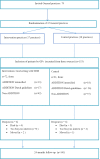Effectiveness of shared goal setting and decision making to achieve treatment targets in type 2 diabetes patients: A cluster-randomized trial (OPTIMAL)
- PMID: 28544171
- PMCID: PMC5600211
- DOI: 10.1111/hex.12563
Effectiveness of shared goal setting and decision making to achieve treatment targets in type 2 diabetes patients: A cluster-randomized trial (OPTIMAL)
Abstract
Objective: About 20% of patients with type 2 diabetes achieve all their treatment targets. Shared decision making (SDM) using a support aid based on the 5-years results of the ADDITION study on multifactorial treatment, could increase this proportion.
Research design and methods: Cluster-randomized trial in 35 former ADDITION primary care practices. Practices were randomized to SDM or care as usual (1:1). Both ADDITION and non-ADDITION type 2 diabetes patients, 60-80 years, known with diabetes for 8-12 years, were included. In the intervention group, patients were presented evidence about the relationship between treatment intensity and cardiovascular events. They chose intensive or less intensive treatment and prioritized their targets. After 1 year priorities could be rearranged.
Follow-up: 24 months. Intention-to-treat analysis.
Main outcome measure: proportion of patients that achieved all three treatment targets.
Results: At baseline 26.4% in the SDM group (n=72) had already achieved all three treatment goals (CG: 23.5%, n=81). In the SDM group 44 patients chose intensive treatment, 25 continued their former less intensive treatment and three people switched from the more to the less intensive protocol. After 24 months 31.8% of the patients in the SDM group achieved all three treatment targets (CG: 25.3%), RR 1.26 (95% CI 0.81-1.95). Mean systolic blood pressure decreased in the SDM group (-5.4 mm Hg, P<.01), mean HbA1c and total cholesterol did not change.
Conclusions: Despite an already high baseline level of diabetes care, we found strong indications that SDM on both intensity of treatment and prioritizing treatment goals further improved outcomes.
Keywords: shared decision making; treatment targets; type 2 diabetes.
© 2017 The Authors Health Expectations Published by John Wiley & Sons Ltd.
Figures
References
-
- Inzucchi SE, Bergenstal RM, Buse JB, et al. Management of hyperglycemia in type 2 diabetes, 2015: a patient‐centered approach: update to a position statement of the American Diabetes Association and the European Association for the Study of Diabetes. Diabetes Care. 2015;38:140‐149. - PubMed
Publication types
MeSH terms
Substances
LinkOut - more resources
Full Text Sources
Other Literature Sources
Medical


